
How It Feels To Be A Flight Attendant Amid Aviation Disasters
Hey friends. This is not the topic I’d hoped would kick off my 2024 blogging, but alas, here we are.
Unless you’ve been living under a rock, you no doubt have seen the news of some major aviation disasters and mishaps in recent weeks. First, there was the collision of a Japan Air flight, resulting in the plane bursting into flames and a full evacuation. And next was a piece of a Boeing 737 Max blown off the aircraft WHILE IN THE AIR, resulting in a giant hole and a rapid decompression. Boeing is in hot water, the crew of the Japan Airlines flight have been hailed as heroes, and all this has me thinking a lot about the industry in which I work.
It’s important, as crew, that we reflect on these mishaps and emergency events, because we never know when we’ll be in one. I think all of us flight attendants are reciting our evacuation commands in our heads, doing silent refreshers on procedures, and praying to everything we love that our customers could be half as good as the ones in that Japan Air evacuation. Many of us, at least here in the US, don’t believe they could be.
At the same time that we are questioning our training and the ability of our passengers to comply, we also are faced with the question of whether the equipment we work in is safe.
Guys, these are weird times to be a flight attendant.
This post is going to be insight into how some flight attendants are feeling in the wake of these newsworthy aviation events. It’s going to discuss how it feels to go to work in an office that might be unsafe because a giant corporation cut corners. And it’s going to try to impress upon you, the flying public, why the safety measures we drone on and on about are, in fact, important. I’m going to tell you how to survive.
Sorry to be morose, or whatever, but we need to have this talk.
Fellow flight attendants: I am holding your hands and having your back during these times of reflection. Members of the flying public: Let’s remember just how much we are on the same team and have the same goals—getting from Point A to Point B SAFELY.
Without further ado, let’s see where this goes.
TRIGGER WARNING: Talk of aviation emergencies. This post is meant as a reflection on current events, and may not be suitable those with a fear of flying. Read with care, and/or follow it up with this post: So, You’re Scared to Fly? Top 7 Tips to Beat Your Fear of Flying.
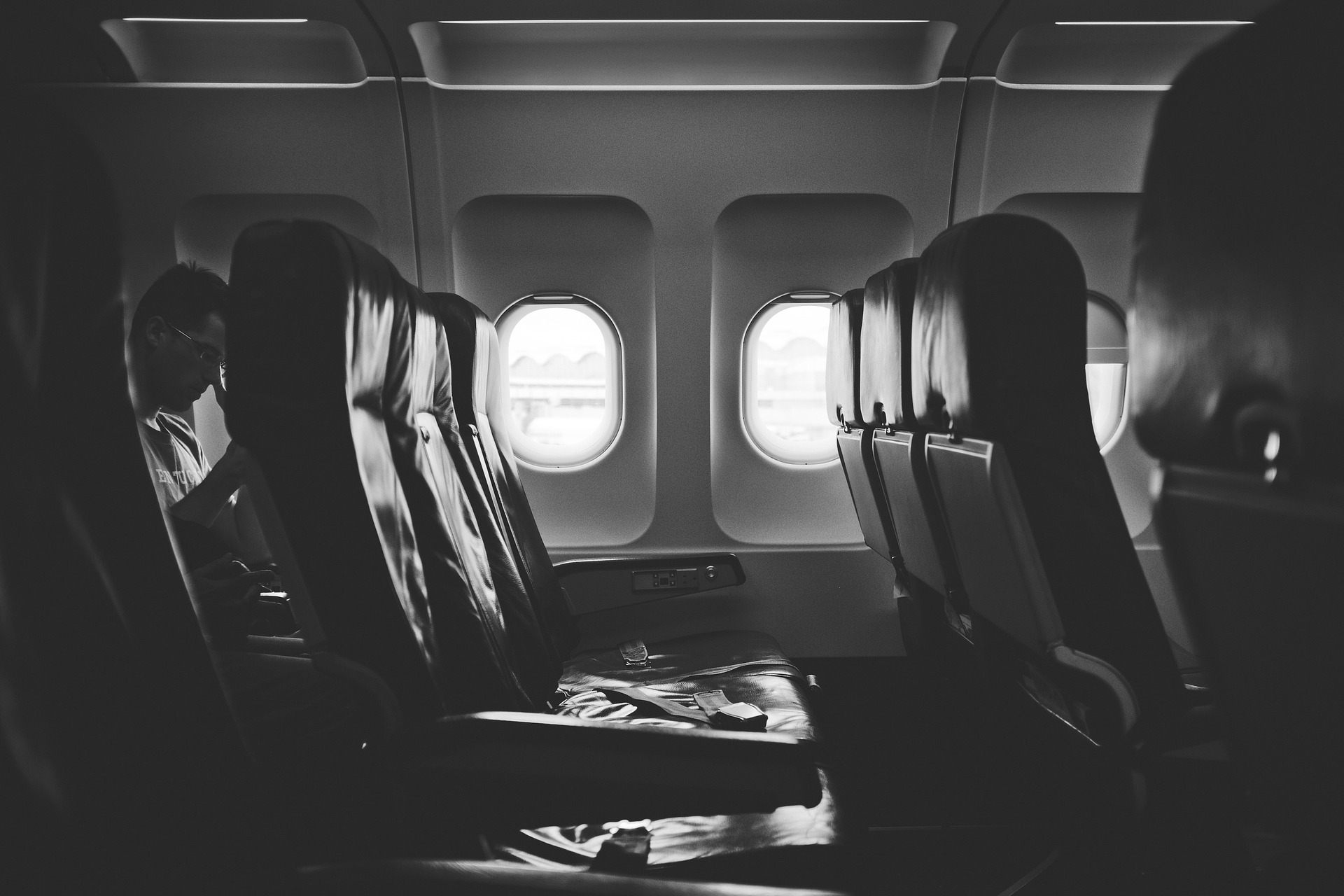
Here goes nothin'
Into A Ball of Flames
JAL Flight 516
On January 2, an Airbus A350 carrying 379 people, Japan Airlines Flight 516, collided into a small Coast Guard Bombardier plane (6 people) in Tokyo’s Haneda Airport. The small plane burst into flames and the larger aircraft caught fire next. The crash was devastating, and while 5 of the 6 people aboard the Bombardier died, with the captain sustaining serious injuries, the crew and customer response on the JAL flight have been hailed as a miracle—all 379 people survived.
It took 18 minutes to get every single passenger safely out and away from the plane. When the PA system in the plane malfunctioned, the crew shouted their evacuation commands through megaphones. They leaned on their training and did a great job. This was a reminder to all of us that crazy sh*t can happen on airplanes. That, while aviation is safe, there is always room for things to go wrong. That every step of our tedious, well-rehearsed training will be worth it on the *one* day in our careers that we might have to use it. We all felt a camaraderie with the crew of JAL flight 516, concern and care for them in what was surely a traumatic experience, and a pride swelled fresh in the work that we do—NOT, as many assume, just “sky waitressing”.
But there was something else to note of the success of JAL flight 516, a critical component: The passengers. And this made many of our hearts sink.

Wreckage from JAL 516. (Kyodo via Reuters)
What Type of Passenger Are You?
The passengers of JAL 516 listened to instructions, left their bags behind, and exited the plane in an orderly way, all while ducking under smoke that was filling the cabin and watching flames rise up out the windows. They were basically the perfect customers. The only people you ever want to have to evacuate.
I think of the travelers I encounter on the day-to-day, mostly nice, mostly just trying to get to where they need to go. But then there is the guy who won’t put his laptop away, after being told by several flight attendants more than once to do so. Who clearly believes his work trumps the safety procedures everyone must follow, who, at the core, thinks he is more important than everyone else around him. There was the woman, just the other day, who let her dog pee in the terminal and walked off from the puddle. Who told me “You can clean it!” when I advised her there was a restroom nearby if she needed paper towels. There are the parents who argue against seatbelts. “She won’t wear it,” they say, to my blinking, incredulous face. (How do you ever ride in the car?)
Many of us flight attendants cheered the crew of JAL 516 and their super compliant passengers, and then we shuddered, imagining the different experience we might have with our own passengers aboard. You need to know this, if you’re a member of the flying public. Your noncompliance is terrifying
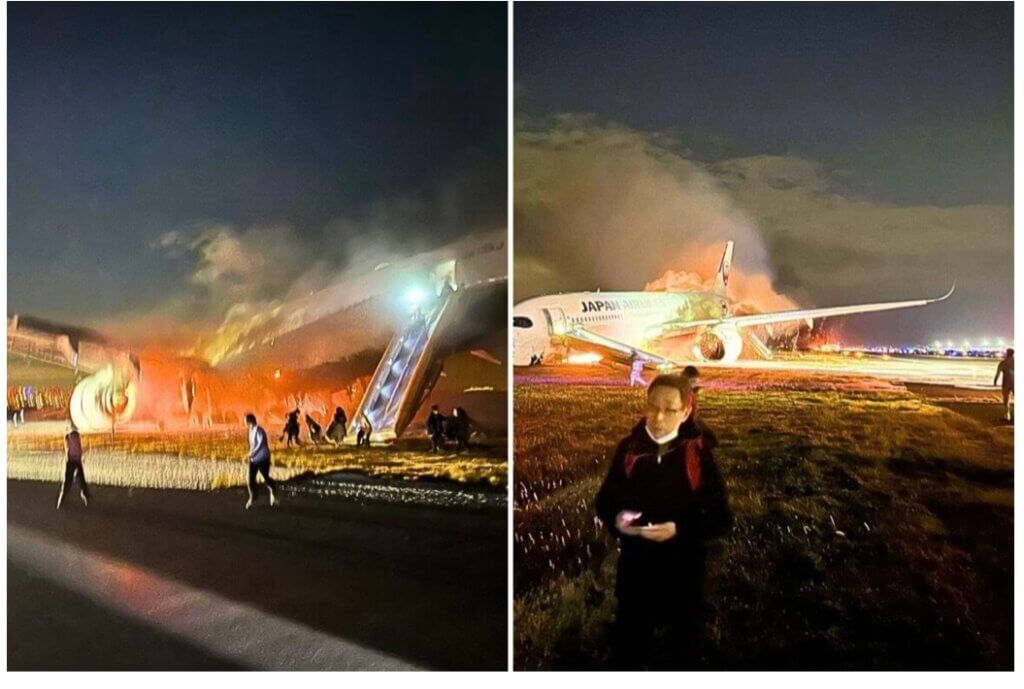
No Carry-Ons. (Kashif Twitter, via AeroTime)
Human Error
Another thing we are dealing with, as the story unfolds, is that the collision was likely caused by human error. Transcripts from Air Traffic Control show that the Coast Guard plane did not have permission to take off when it taxied onto the runway, but based on reading this Associated Press article, I can maybe see why there was confusion.
Here is the thing about aviation: This shit is tedious. Repetitive. We use these repetitive, tedious, methods of checks and re-checks in everything we do, from the maintenance techs to flight attendants, to pilots and Air traffic controllers, and with good reason. Each annoying, tedious task is a layer of “Swiss cheese”. Meaning, there is always the chance for an error to slip in at some point of the process. But when you have these protections layered one on top of the other, it becomes less and less likely that the threat or error will make its way through the “hole” of the Swiss cheese. The problem with humans is we get bored, and we get comfortable. We do something day in and day out and it becomes second nature, muscle memory. When we’re not fearful or tense or new, we can get lax. Think about all the dangers on the roadways you encounter; and yet you probably still turn up your music, enjoy the scenery, relax while driving. You might not think of all the things you’re doing, all the little components that make up “driving,” at all.
It is scary to think of human error causing a deadly catastrophe. It is scary to know that we only have control of the very small things we do inside the cabin. We must put so much trust in the pilots, in Air Traffic Control, in plane manufacturers (which we will get into next), and in our passengers. When all these work groups function well, we make an unstoppable team: Safe, on-time flights being the end goal. But when one of these things breaks down—communication over the radio, a flight attendant getting distracted, passengers who care more about their bags than other people’s lives—it can be with deadly results.
I am simultaneously cheering on the crew and passengers of JAL 516, and experiencing a heavy heart, a tiny seed of anxiety. Would you, members of the American flying public, behave as those passengers did—orderly and selflessly? Or would you allow others to die? Would you endanger my life?

I've been thinking, I've been thinking...
Let’s (NOT) Blow The Doors Off This B*tch
Alaska Air Flight 1282
On January 5, an Alaska Airlines flight leaving Portland OR for Ontario CA, experienced a rapid decompression after a “door plug” blew off the side of the plane at 16,000 feet. A “door plug” is an airplane part that ‘plugs’ the hole of where an emergency exit door *could be*. The planes are designed with spaces for several doors, but the airline ordering the equipment decides how many doors are needed. If one is not needed, a “door plug” is installed, bolted into the plane, and from the inside it looks like just another section of the wall of an aircraft.
Until it flies off into the night sky and lands in someone’s back yard.
Aircraft cabins are pressurized, so blowing a hole in the equipment caused a rapid decompression. Oxygen masks fell and the cockpit door abruptly, and unexpectedly, swung open. Luckily, no one was sitting directly next to the gaping hole in the fuselage, the pilots stabilized and then landed the plane safely, and no one was hurt. But let’s talk about the implications of this event.
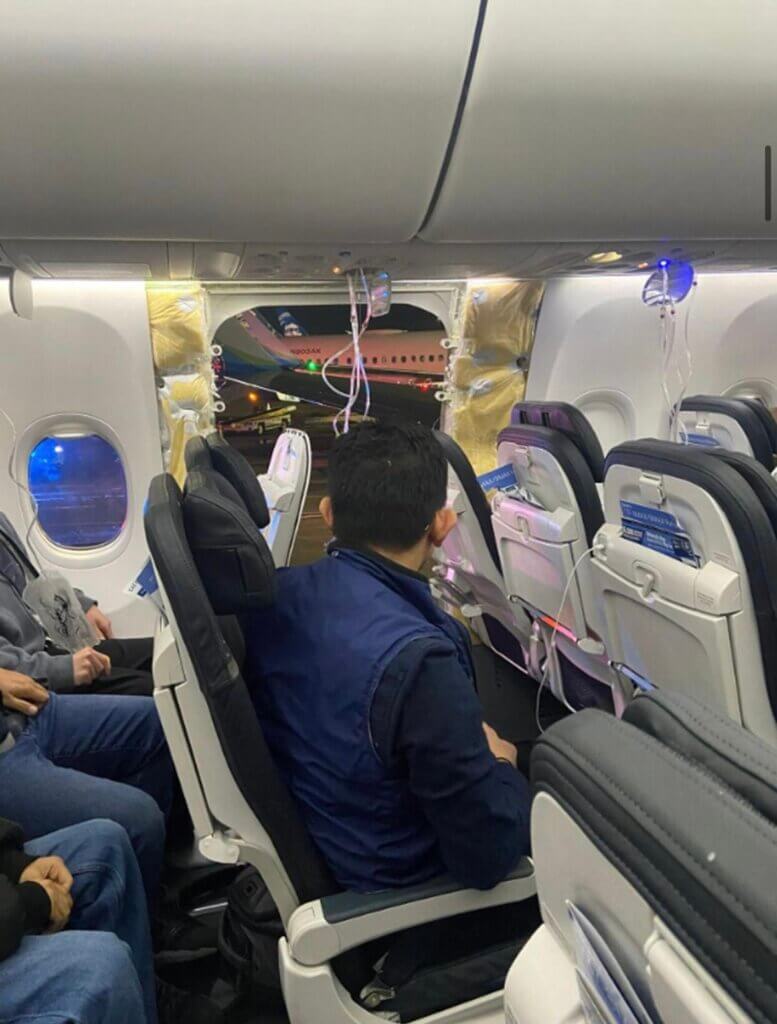
Door Plug missing on Alaska Flight 1282 (Passenger Kyle Rinker took this photo. Found on CBS58)
Other Max Incidents
The plane in question was a Boeing 737 Max 9, which may sound familiar because of newsworthy problems in 2018 and 2019 with its predecessor, the 737 Max 8.
The incidents with the Max 8 were deadly plane crashes (Lion Air flight 610 and Ethiopian Airlines flight 302) in which the MCAS system installed caused the airplanes to nosedive into the earth and sea. I can’t get into the full nitty-gritty of the MCAS system, but if you’d like to read more about it, click here. The thing to know is that two important features for understanding and operating an aircraft with this MCAS system—a sensor and a display—were optional features for an additional fee. Yep, that’s right, a paywall. A premium version. An “upgrade” that would be the only way to make this system safe. In 2016, Boeing petitioned the FAA to have information about the MCAS system removed from their manuals, and the FAA approved it. Therefore, Pilots flying these Boeing 737 Max 8s were never trained to over-ride this nose-diving system.
A total of 346 people were killed in these crashes.
And here we are in 2024, and the newest Boeing 737 Max is dropping airplane parts mid-air.
Obviously, this incident was not nearly as serious as the nose-dive crashes of 2018/9, but there are some chilling similarities that must be examined. One is the lack of information and training. Pilots flying this Alaska Airlines flight did not know the cockpit door would swing open in the event of a decompression. This is something that should be clearly stated in the equipment manual. (For those of you who don’t know, a locked cockpit door is *ESSENTIAL* for the security of a flight.)
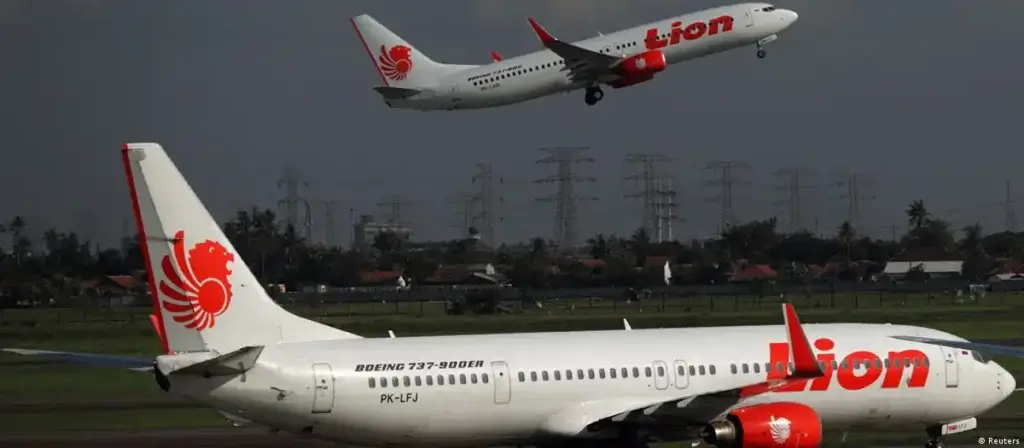
Lion Air flight 610 was the first accident for the 737 Max 8. (via Reuters)
Safety, Money, and Corporate Greed
The other similarity is what looks like a wonton disregard for safety and quality control. The door plug that flew off the fuselage should have been held tightly by TWELVE bolts. And somehow all twelve of them were disengaged. Since the incident, and the grounding of all 171 Boeing 737 Max 9s with door plugs, both Alaska Airlines and United Airlines have found loose bolts in their door plugs. The FAA has said all Max 9s (with door plugs) will remain grounded until Boeing creates sufficient instruction for operators on inspection and maintenance.
It turns out that Spirit AeroSystems (No relation to Spirit Airlines!), the maker of Boeing door plugs and most of the company’s airplane parts, was sued in a class action lawsuit for widespread quality failures. Employees even alleged they were encouraged to falsify documents. They were so bad, in fact, that Boeing put the supplier on probation from 2018 to 2021. It is yet to be discovered whether the issue with these Max 9 door plugs was due to Spirit AeroSystems manufacturing or the assembly line at Boeing.
But either way, there is only one conclusion I can draw. Safety is not the number one priority at Spirit AeroSystems, nor at Boeing. The irony of Boeing being one of the only American aircraft manufacturers is not lost on me. I call this country home, and I know firsthand how our unhinged version of late-stage capitalism can be oppressive, if not deadly. I have seen the banks in our country, too big to fail, swindle the American people out of their life savings, tank the entire economy. I have watched “healthcare” companies gauge prices for life-saving medication. Coca-Cola stealing and bottling the world’s water to sell back to us, while millions of people no longer have access to safe drinking water. I work in Corporate America, and thankfully, I like the company I work for. They have not caused me any injury. But I do know that I’m allowed to work more than 20 hours in a day, indefinitely, even, as if I’m a robot. I know that I am asked to sit at work for long FREE hours. I know that every changes made to our operations are directly correlated to money.
The story of Boeing is so un-unique here that it’s not even surprising. “Big Corporation Saves Money by Skipping Safety Features” only makes headlines when there is a viral video or hundreds of people dead. It has been this way since the beginning of the industrial revolution, and under capitalism, workers are always at risk. We saw this during COVID, with the lowest-paid workers forced to show up and shoulder the rest of us, while they put their own health at risk. We saw it with garment factories and on the railroads. And we will continue to see unsafe conditions for workers and the American public, if corporations are allowed to make their own rules and monitor their own behavior.
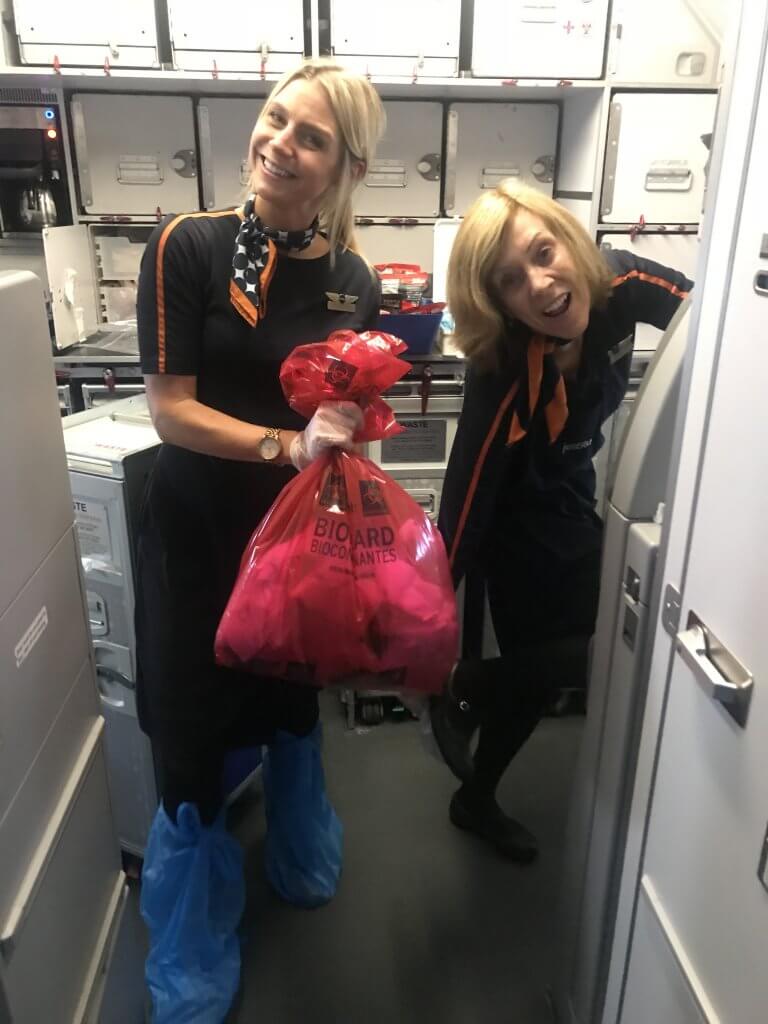
I have big dreams of me, and my co-workers, and all the other workers around the world feeling SAFE at work.
What do we need?
Unions. Regulations. Accountability. Harsh, example-making punishments for negligence. Protections for whistle blowers. A zero-tolerance attitude for corporations putting lives at risk—including via pollution and excessively risky financial bets. THESE are the things that will improve safety and quality standards. THESE are the protections needed when corporations run every facet of American life, including politics, pharmaceuticals, what we eat, drink, and the literal air we breathe.
I don’t think every Boeing plane is unsafe. But I, a flight attendant, am hesitant to fly on a 737 Max. The trust has been lost, and Boeing—along with the FAA—is going to have to take major leaps to earn any of that trust back.
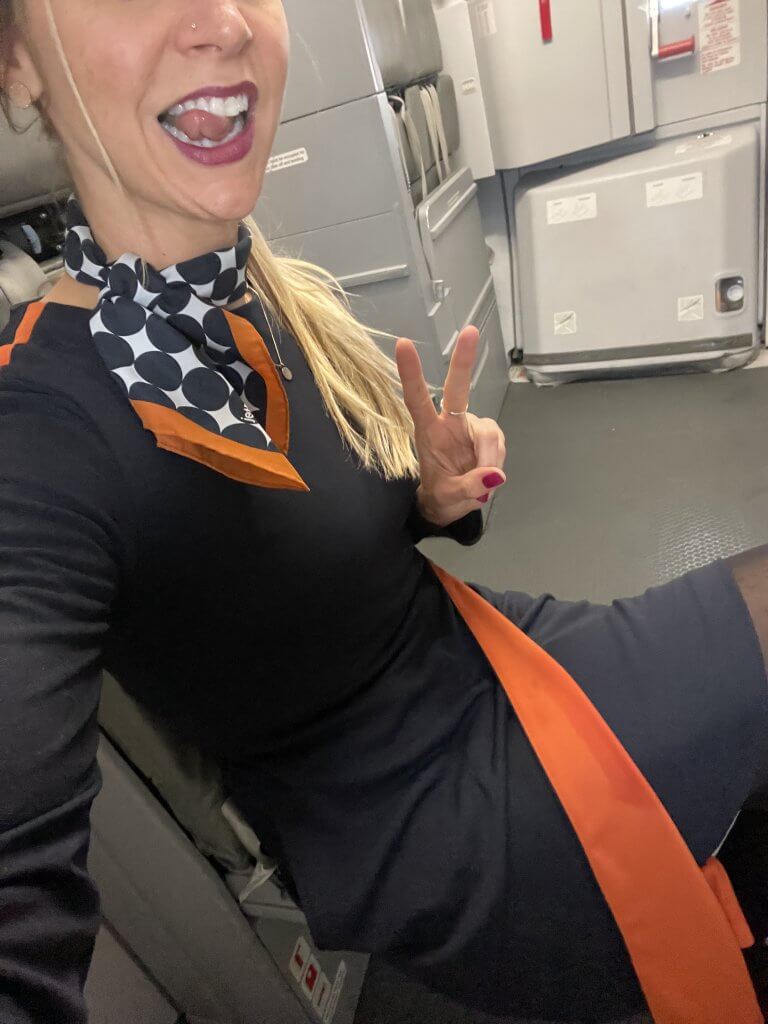
Representation is sexy. Organize, organize, organize.
How To Survive an Aviation Emergency
& Be The BEST Kind Of Passenger
Now that we’ve analyzed some of the current events making news and giving flight attendants pause, let’s talk about what passengers can do to ensure their flight is as safe as possible and that any emergency will have the best result.
As airline passengers, your role is SUPER important in any evacuation or emergency situation. You are your flight attendant’s backup, your fellow traveler’s assistant, and it takes all of us working together to have a favorable outcome. Compliance is the most boring topic of all among passengers, but let’s talk about a few quick things that actually make a huge difference.
1. Bags
This is an impassioned plea. If you ever, ever are in a situation where evacuation is necessary, LEAVE YOUR BAGS. ALL OF THEM.
The JAL Flight 516 passengers left their bags and got the hell out of the plane before it was burned into a pile of ash. Their cooperation with flight crew is exactly how people should behave in an emergency situation. But a few years ago, in 2019, there is an example of stark contrast. When Aeroflot flight 1492 (a Sukhoi Superjet 100) crashed in Moscow after a lightning strike, customers were seen running from the aircraft with carryon luggage. Forty-one of the 78 people aboard (including crew) died in this crash. These passengers were vilified in the media, and with good reason. Their seconds spent gathering belongings prevented the people behind them escaping. Almost everybody seated behind row 11 died, including the crewmember in the back.
For full transparency, the majority of the damage from the crash was sustained in the back of the aircraft. Even without the bag-gathering, it would have been harder for passengers in the back to survive. But just an extra few seconds could have made the difference for so many families touched by this tragedy. Just two more survivors, four, seven. Think about it.
Please, please, keep your humanity intact in the event of emergency. Leave all your belongings and GO.
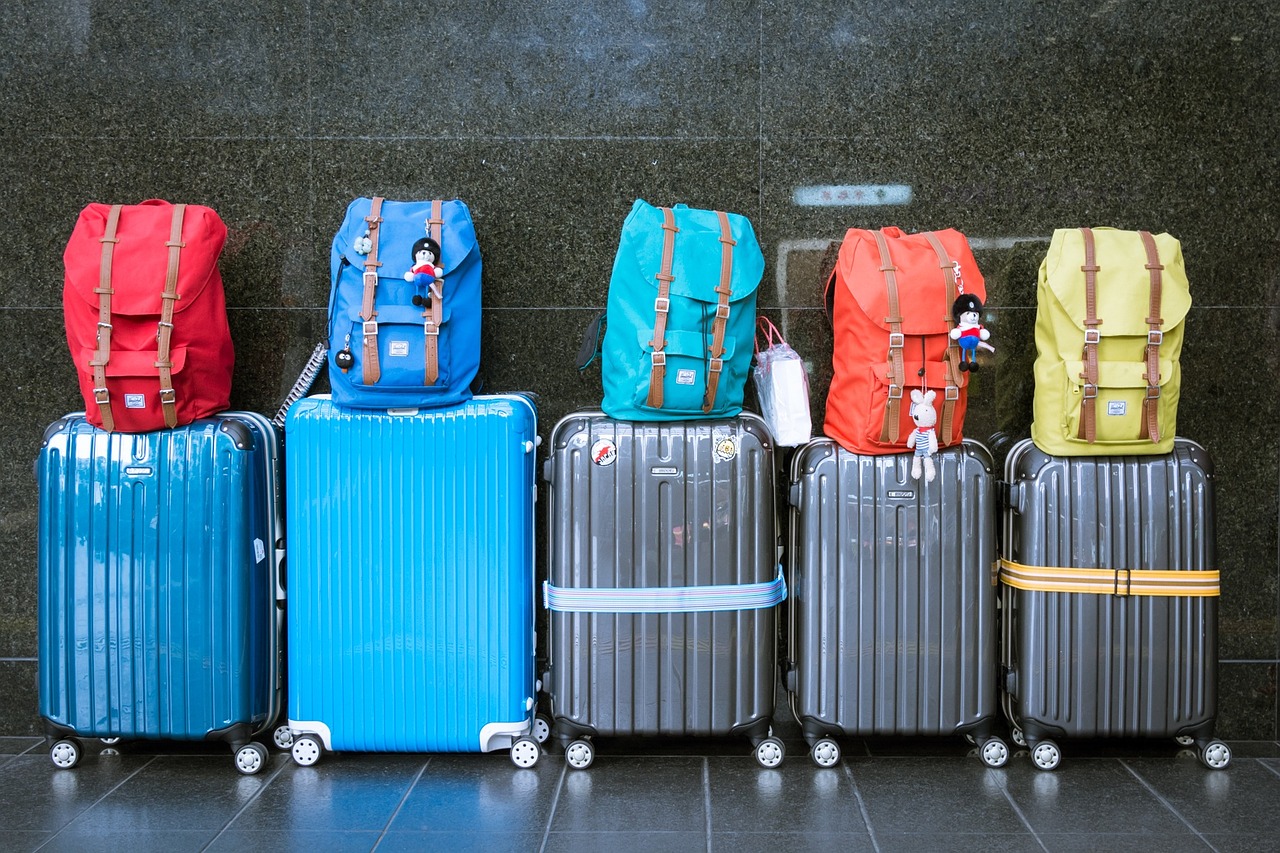
Channel your inner Beyonce and remember it's all replaceable.
2. The Safety Information Card
One of the annoying things flight attendants deal with on a daily basis is people in the exit row rolling their eyes, snapping at us, or refusing to cooperate during the *required-by-law* safety briefing.
Let these recent incidents remind everybody that sitting in the exit row is an actual responsibility. There COULD come a day when you actually have to open the door or help people evacuate. Everyone who is sitting in an exit row is told to review the safety information card in the seatback pocket, and during the taxi-out safety briefing (which happens with in-person or on-screen demonstrations), every customer is advised to do the same. Most people are reading, watching TV, listening to a podcast, talking, or sleeping during this time.
I’m not saying you need to know everything about every aircraft or never use a personal device during the safety demo. What I am advising is that you take the safety card out of the pocket, open it up, and give it a glance at the start of your flight. There is no reading required, it is a picture book! And you would be amazed at how simple the instructions are. It tells you how to operate the doors, how to brace for an emergency, how to evacuate in land and water, basically all the good stuff. Next time you’re flying, take three minutes out of your Netflix binge or WFH time and check out the Safety Information Card. You will feel seriously informed.

I promise the rules aren't just for our amusement.
3. Seatbelts:
There is nothing like seeing a gaping hole, blown out of a flying aircraft, to remind you how important seatbelts are. Just imagine sitting in the seat next to that missing door plug—the wind from outside, freezing, whipping in, while the plane rapidly descends to stabilize pressure in the cabin. People can lose consciousness in a decompression, and being unbuckled and unconscious could have been disastrous on this particular flight.
Turbulence
American travelers have been conditioned to see the seatbelt sign as a suggestion. They do not feel the fear, and they do not heed the warnings. Most of the time it’s fine. Some light chop isn’t going to kill anybody. I’d rather someone hold on tight and stay locked in the bathroom than pee their pants waiting for the sign to turn off. But within reason.
Often when the pilot switches on the fasten seatbelt sign, it is because worse turbulence is predicted up ahead. There is also a type of turbulence called “Clear Air Turbulence,” which yields no warnings whatsoever. You’re flying along, and BAM, dropping hundreds of feet out of nowhere. Injuries happen here. Heads hit ceilings and skulls break through overhead bins. Luggage falls from above. Drinks splash about, and aisle service carts can also be lifted into the air, seriously injuring anyone in the vicinity.
A good way to gauge the severity of turbulence is this: Are your drinks spilling? Is someone praying? Are the flight attendants seated and buckled up? If the answer to any of these is “yes” then stay buckled up and wait for things to smooth out before getting up.
On Kiddos & Runways
Another all-too-common trend is parents not wanting to buckle up their small children. “He’ll cry if I buckle him,” parents have said. While rolling down the runway, strapped into my jumpseat, I’ll look up and see a toddler teetering along down the aisle, parents smiling.
Quick reminder that plane crashes can and do happen on runways. The Japan Airlines FIREBALL EXPLOSION took place on the runway. There are also less serious, but still dangerous accidents that can happen: An aircraft clipping the wing of another, a catering truck striking an aircraft, sliding on ice on the runway. All of these incidents, not serious enough to require evacuation, would still cause abrupt jolts in the aircraft, great swings side to side. There goes the toddler’s head against an arm rest. Oops, you dropped the baby you were passing back and forth onto the hard floor.
People forget because these things don’t happen often, but they certainly can and do happen. Please be careful, heed the seatbelt sign, and make sure those kiddos are buckled up. We will forgive the crying, but let’s keep that baby safe. <3

Buckle up, buttercup.
4. Tripping Hazards
There are some things you all roll your eyes at. And I get it, they sound silly. Here are the most common, and the reason you should still comply:
- Unplugging devices from power outlets—I don’t know if there is an electrical component to this rule, but I do know your cord is a tripping hazard that could cost a life in a high-stakes evacuation.
- Bags all the way under the seat—Same. We don’t want anyone to waste precious minutes falling down and having to get back up.
- Laptops and Similar sized devices– They will trip you or your neighbor. They could also be tossed about during a bumpy takeoff/landing and cause injury to you, or worse, someone else.
5. Smoking/Vaping
The obvious reason there is no smoking allowed is that we do not want a fire to break out at 30,000 feet. Flight attendants are trained in firefighting, and it is the absolute LAST thing I ever want to do. But what about Vapes and e-cigarettes?
Well, rule breakers, for one thing it could set off the smoke detector in our planes, sending a false alarm to our pilots. As you can imagine this is a scary message to receive in the air, and could result in them behaving accordingly (as if there were a real fire on board.) Flight attendants visually seeing smoke in the cabin could cause the same issue. You don’t want us freaking out every person on board and preparing for a diversion because of your vape, right?
Imagine, for a second, that we allowed vaping on planes. We all became accustomed to smoky puffs wafting about the interior of the aircraft. This would strip flight attendants of our ability to recognize an actual fire in a timely manner. We would think the smoke was normal, “probably just a vape” and then have to wait until we smelled the fire or felt its heat to know there was danger. I don’t know about you, but I would prefer to be able to see the signs of fire as quickly as possible.
And beyond that, no one wants your vape chemicals in their lungs. So, please, wait with the rest of the smokers until you get off the plane.
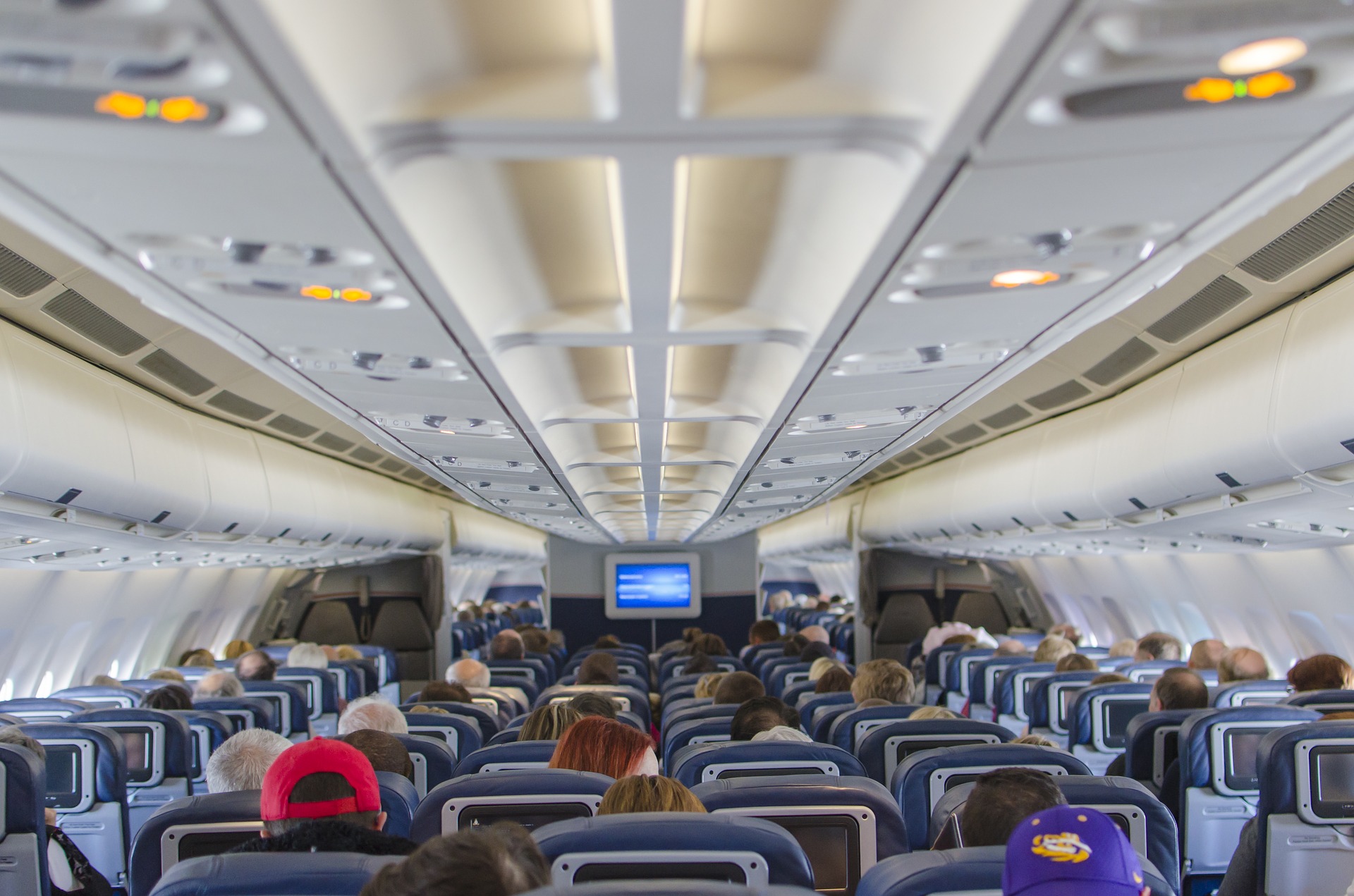
Let's all do our best to make this a safe space. (Creative Commons)
6. Awareness
Be aware of your surroundings.
You are our assistants. You are on our team. YOU can make a difference in aviation safety. If you see something, hear something, feel something, or smell something that doesn’t seem normal, let a flight attendant know. Sometimes they’ll tell you the thing is, in fact, normal and can give you a brief explanation. But it is always worth mentioning something that feels “off” to you.
If you find yourself in a scary event or emergency situation, try to remember that things can change rapidly and paying attention is more important than filming a Tik Tok video. If something non-normal starts happening on your flight, turn off your noise-cancelling, take your headphones out, listen to announcements. (Actually, try to listen to announcements even when there’s not an emergency. Then you won’t have to ask me what we have for snacks, how to log into the Wi-Fi, or what time we’ll be landing. Just a thought.)
Please don’t get drunk on the plane. Please don’t mix your anxiety pills with alcohol. Please drink enough water so you don’t faint. Please let your flight attendants know any pertinent information—I have an allergy, I’m hard of hearing, No hablo ingles, for example. Anything that would affect your ability to complete the flight, or an evacuation, safely.
And that concludes my tips for how to be the safest passenger possible. It is hard to give these basics of air travel without sounding snarky or condescending, but that’s not my intention. The truth is many people don’t know this stuff. The rules can seem arbitrary or stupid—like the vaping, or unplugging your phone for takeoff—procedures created to boss people around and have some sense of authority. But once you dig a little deeper, you’ll see there is a reason for all of it. I can tell you with certainty that flight attendants enjoy enforcing these rules just as much as you enjoy being told what to do. Not at all. Let’s just all make each other’s lives easier (and safer.)
Truce? Teammates?
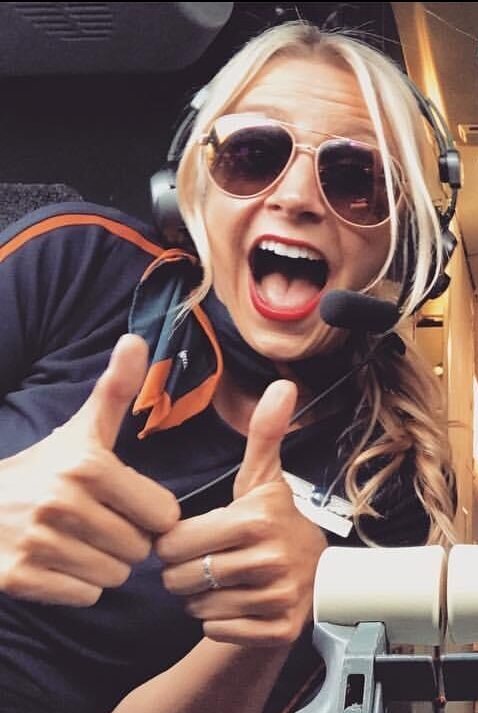
We got through it together. Teammates!
I hope that this post did not terrify anybody. Air travel is STILL much safer than driving, and the reason these incidents are so amplified in the media is because of their rarity. I just wanted to highlight how it feels for flight attendants right now—this flight attendant, anyway—during these huge aviation events.
I hope the crew of JAL 516 got some time off and some therapy after this event. I hope all the survivors are holding their loved ones tightly and passing along the wisdom gleaned from a successful evacuation. I wish peace and solace for the families of the victims on the Coast Guard jet, who did not survive. And I hope Boeing can get its shit together and become a corporation that puts safety above all else.
I hope none of you ever has to evacuate an aircraft, or fight a fire in the air, or have any scary experience while flying. I hope the same for myself.
To my co-workers and my teammates: Take care of yourself. But let’s also take care of one another.
<3

Here are some of the sources used in the making of this post.
JAL 516
Japan plane crash: Transcript sheds light on moments before collision | AP News
Successful evacuation from burning Japan Airlines jet highlights dogged devotion to safety | AP News
How JAL 516 evacuated all 379 onboard with zero casualties – AeroTime
Aeroflot 1492
Did Passengers Cause Fatalities In Aeroflot Superjet Crash in Russia? – Plane & Pilot Magazine (planeandpilotmag.com)
Alaska Air 1282
Scare on Alaska Airlines Flight 1282: A loud bang, a whooshing sound and a boy’s shirt sucked right off (cbs58.com)
All 737-Max 9 jets to remain grounded until Boeing sends new instructions, FAA says (yahoo.com)
Boeing



Rae
Whewwwwwww 😰